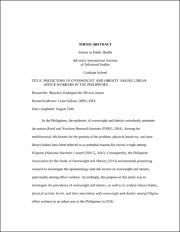Predictors of overweight and obesity among urban office workers in the Philippines
Abstract
In the Philippines, the epidemic of overweight and obesity noiselessly permeates the nation (Food and Nutrition Research Institute [FNRI], 2014). Among the multifactorial risk factors for the genesis of the problem, physical inactivity, and poor dietary habits have been referred to as potential reasons for excess weight among Filipinos (National Nutrition Council [NNC], 2015). Consequently, the Philippine Association for the Study of Overweight and Obesity (2015) recommends pioneering research to investigate the epidemiology and risk factors of overweight and obesity, particularly among office workers. Accordingly, the purpose of this study was to investigate the prevalence of overweight and obesity, as well as to analyze dietary habits, physical activity levels, and their association with overweight and obesity among Filipino office workers in an urban area in the Philippines in 2016.
Seeking to accomplish the purpose of this study, a descriptive correlational study design was used to measure the relationship between the variables among a single group of individuals (Creswell, 2012), the urban office workers. Within a selected establishment, 221 observations were analyzed. This was done using two self-administered questionnaires—International Physical Activity Questionnaire (IPAQ; Cronbach’s alpha 0.76) and Food Frequancy Questionnaire (FFQ; Cronbach’s alpha 0.84). In addition, anthropometric measurements were taken to identify body sizes and forms.
In this study, the prevalence of overweight and obesity among the targeted office workers was 60.2% based on the international standards of body mass index (BMI; WHO, 2015). Moreover, 67% and 73% of the participants were classified as having a high waist circumference (WC) and waist-hip ratio (WHR), respectively. Regarding physical activity, only 7.7% (n = 17) of the participants were considered to be sufficiently active (high active). A broad look at the overall dietary habits showed that unhealthy food groups were the most frequently consumed.
A significant negative correlation between physical activity and BMI, WC, and WHR was found. In terms of dietary habits, there was a significant positive correlation between foods to limit or avoid and WC. Significant models emerged. Urgent actions are needed to prevent and treat the current epidemic of overweight and obesity among office workers. Promoting lifestyle changes through physical activity and dietary habits may help to reduce the overweight and obesity problem. Exploring other predictors of overweight and obesity may illuminate the intricacies of the current epidemic. Longitudinal, experimental, and qualitative studies as recommended as well.


